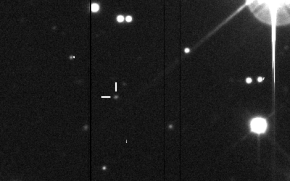 Megaclite imaged by the Canada-France-Hawaii Telescope in December 2001 | |
| Discovery [1] | |
|---|---|
| Discovered by | Scott S. Sheppard David C. Jewitt Yanga R. Fernandez Eugene A. Magnier |
| Discovery site | Mauna Kea Observatory |
| Discovery date | 25 November 2000 |
| Designations | |
Designation | Jupiter XIX |
| Pronunciation | /mɛɡəˈklaɪtiː/ |
Named after | Μεγακλειτή Megaclītē |
| S/2000 J 8 | |
| Adjectives | Megaclitean /ˌmɛɡəklɪˈtiːən/ |
| Orbital characteristics [2] | |
| Epoch 27 April 2019 (JD 2458600.5) | |
| Observation arc | 16.26 yr (5,938 days) |
| 0.1586666 AU (23,736,190 km) | |
| Eccentricity | 0.4102170 |
| –747.09 d | |
| 269.64681° | |
| 0° 28m 54.732s / day | |
| Inclination | 143.20224° (to ecliptic) |
| 356.52408° | |
| 8.71854° | |
| Satellite of | Jupiter |
| Group | Pasiphae group |
| Physical characteristics[3] | |
| ≈ 6 km | |
| Albedo | 0.04 (assumed) |
| 21.7[4] | |
| 15.0[2] | |
Megaclite /mɛɡəˈklaɪtiː/, also known as Jupiter XIX, is a natural satellite of Jupiter. It was discovered by a team of astronomers from the University of Hawaii led by Scott S. Sheppard in 2000, and given the temporary designation S/2000 J 8.[5][1][6]
Megaclite is about 6 kilometres in diameter, and orbits Jupiter at an average distance of 24,687,000 kilometers in 747.09 days, at an inclination of 150° to the ecliptic (148° to Jupiter's equator), in a retrograde direction and with an eccentricity of 0.308.
It was named in October 2002 after Megaclite, mother by Zeus (Jupiter) of Thebe and Locrus in Greek mythology.[7][8]
It belongs to the Pasiphae group, irregular retrograde moons orbiting Jupiter at distances ranging between 22.8 and 24.7 Gm, and with inclinations ranging between 144.5° and 158.3°. However, while Pasiphae is gray (B−V=0.74, V−R=0.38, V−I=0.74) in color, Megaclite is light red (B−V=0.94, V−R=0.41, V−I=1.05) and come similar to Callirrhoe.[9]
- ^ a b MPEC 2001-A29: S/2000 J 7, S/2000 J 8, S/2000 J 9, S/2000 J 10, S/2000 J 11 2001 January 15 (discovery and ephemeris)
- ^ a b Cite error: The named reference
MPC115890was invoked but never defined (see the help page). - ^ Cite error: The named reference
jpl-physwas invoked but never defined (see the help page). - ^ Cite error: The named reference
SheppardMoonswas invoked but never defined (see the help page). - ^ IAUC 7555: Satellites of Jupiter Archived 2002-09-16 at the Wayback Machine 2001 January 5 (discovery)
- ^ MPEC 2001-T59: S/2000 J 8, S/2000 J 9, S/2000 J 10 2001 October 15 (revised ephemeris)
- ^ IAUC 7998: Satellites of Jupiter 2002 October 22 (naming the moon "Magaclite")
- ^ IAUC 8023: Satellites of Jupiter 2002 November 29 (correcting the name)
- ^ Grav, Tommy; Holman, M. J.; Gladman, B. J.; Aksnes, K. (2003). "Photometric survey of the irregular satellites". Icarus. 166 (1): 33–45. arXiv:astro-ph/0301016. Bibcode:2003Icar..166...33G. doi:10.1016/j.icarus.2003.07.005. S2CID 7793999.

